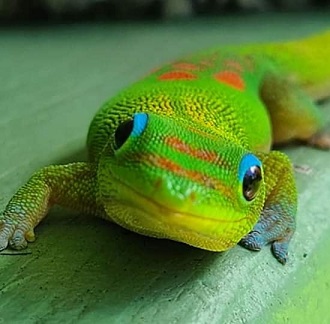The Coastal Taipan (Oxyuranus scutellatus)
COASTAL TAIPAN
The
coastal Taipan (Oxyuranus scutellatus) in English is called the coastal Taipan
or common Taipan, a species of Taipan that is widespread on the north and
east coasts of Australia, and the island of Papua. It is the third deadliest
venomous land snake in the world after the inland Taipan and eastern
brown snake based on LD50 testing of rats. The specific name of this snake,
scutellatus, means "belligerent".
Physical description
The Coastal Taipan is the longest venomous snake in Australia, However, common
specimens are only about 1.2 meters long (including the tail). Some other
specimens are between 1.5 to 2 meters long. Other types of Taipans, including land Taipans, can reach similar sizes despite being smaller in average size.
Specimens of coastal Taipans with an average length of 2 meters weigh about 3
kg.
According
to the Queensland Museum, the coastal Taipan's recorded length size is a
specimen measuring 2.9 meters long and weighing up to 6.5 kg. However, although
rare, larger specimens are widely believed to exist, including specimens that
reach 3.3 meters in length.
The
coastal Taipan's head is long and narrow in size as in the African black mamba
(Dendroaspis polylepis), but it is not coffin-shaped. The two world's deadliest
snakes converge on each other in several aspects of morphology, ecology, and
behavior, The coastal Taipan has an angular forehead and a faded face. The body
is slender with varying colors, often light olive or reddish-brown, but some
specimens can be dark gray to blackish.
The
color on the sides of the body is lighter, while the lower part of the body
(ventral) is usually white-beige to pale light yellow, and there are often
orange or pink stains or spots. Each specimen undergoes seasonal changes in
coloring, darkening in winter and fading in the summer. The snake's eyes are
large and round, with a light brown or often dark brown color with large pupils
The
arrangement of scales on the body of the coastal Taipan consists of temporal
scales as much as 2 +3 (3 +4), dorsal scales (upper body) as much as 21–23 rows
in the middle of the body, ventral scales 220–250, single anal scales
(undivided), subcaudal scales as much as 45–80 and divided.
Deployment and habitat
Coastal
Taipans are widespread in northern Australia and the island of Papua. There are
two subspecies of coastal Taipans
O.
s. cani – Papuan Taipan, Papuan Taipan, or New Guinean Taipan. It is spread
across the southern island of Papua, which includes the provinces of Papua,
Indonesia and Papua New Guinea.
O.
s. scutellatus – Coastal Taipan. It is spread across the north to east coast of
Australia, which includes the northeast [{Western Australia]], the coast of the
Northern Territory, to the east coast of Queensland.
Coastal
Taipans can be found in a variety of habitats. This snake can be found in warm
and wet areas to tropical coastal areas, monsoon forests, sclerophly forests,
open forests (woodlands), as well as grasslands both natural and artificial,
and piles of unused goods. Coastal Taipans love unkempt animal burrows, hollow
logs, and piles of vegetation or foliage as shelters.
Behavior and reproduction
Coastal
Taipans travel during the day (diurnal), often in activities during the day,
although they may be active at night when weather conditions are hot. The main
food is rodents, milkfish, and some types of birds.
Coastal
Taipans breed by laying eggs (oviparous). The number of eggs produced is about
11 eggs.
LITERATURE
Oxyuranus
scutellatus in the Reptarium.cz Reptile Database
["CSL
Taipan Antivenom". CSL Antivenom Handbook. www.toxinology.com. Retrieved 7
December 2011.
[
Ernst, Carl H.; Zug, George R. (1996). Snakes in Question: The Smithsonian
Answer BookReligible (free). Washington, District of Columbia, USA: Smithsonian
Institution Scholarly Press. ISBN 1-56098-648-4.
[
Thomas, Séan; Griessel, Eugene (Dec. 1999). "LD50". Archived from the
original on February 1, 2012.
[a
b Coastal Taipan (Oxyuranus scutellatus) at the Australian Reptile Online
Database | AROD.com.au
[
a b "FAQ: Snakes". Australian Venom Research Unit. University of
Melbourne. Retrieved 7 December 2011.
[
"Archived copy". Archived from the original on 2007-07-16. Retrieved
2012-12-19.
[
"Oxyuranus scutellatus - General Details". Clinical Toxinology
Resource. University of Adelaide. Retrieved April 17, 2012.
[a
b Shine R, Covacevich J (1983). "Ecology of highly venomous snakes: the
Australian genus Oxyuranus (Elapidae)". Journal of Herpetology. 17: 60–69.
doi:10.2307/1563782.
[
a b "Coastal Taipan". Queensland Museum. Retrieved April 17, 2012.
Coastal
Taipan - The Australian Museum
[
Hoser RT (May 2002). "An overview of the taipans, genus Oxyuranus
(Serpentes: Elapidae) including the description of a new subspecies".
Crocodilian - Journal of the Victorian Association of Amateur Herpetologists. 3
(1): 43–50.
[
"Devenomized - Oxyuranus scutellatus" (PDF). Devenomized. Archived
from the original (PDF) on 25 April 2012. Retrieved April 17, 2012.
[
"Oxyuranus scutellatus (W. Peters, 1867)". Integrated Taxonomic
Information System.
[
a b O'Shea, Mark (1996). A Guide to the Snakes of Papua New Guinea. Port
Moresby, Papua New Guinea: Independent Publishing Group. 251 pp. ISBN
981-00-7836-6.
[
a b "Animal Species: Coastal Taipan". Australian Museum. Retrieved
April 17, 2012.






